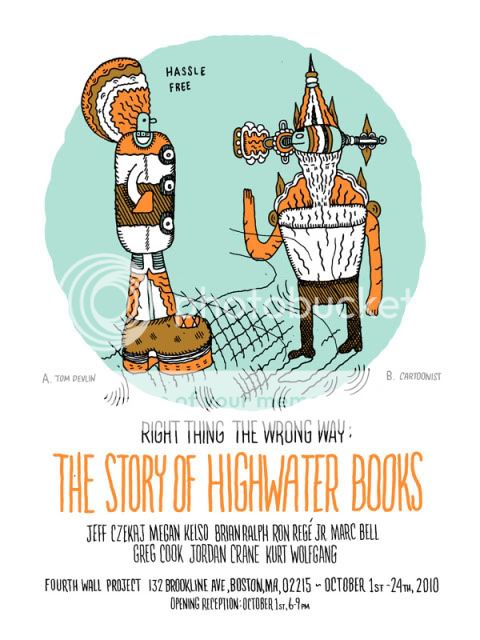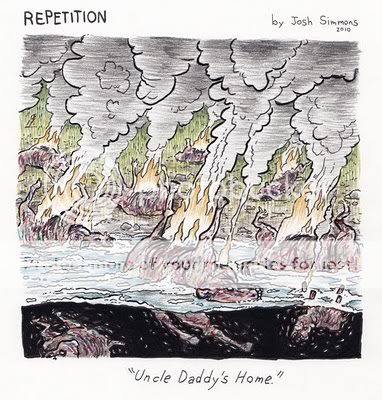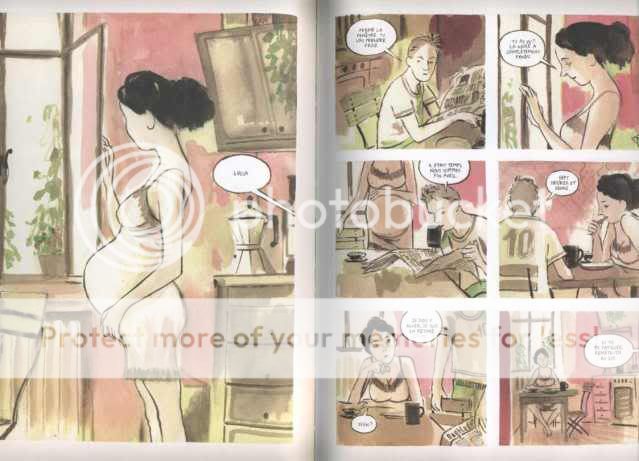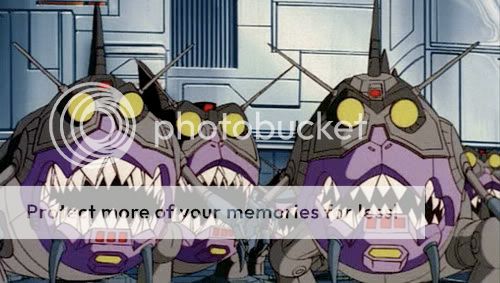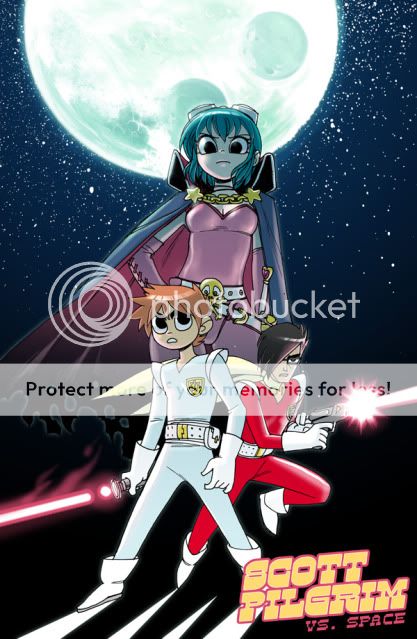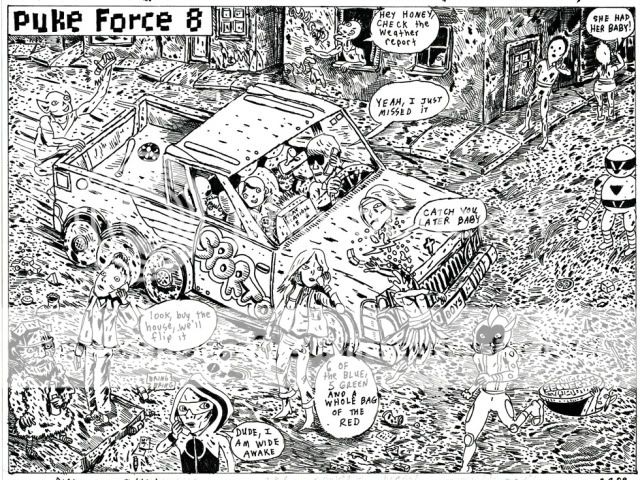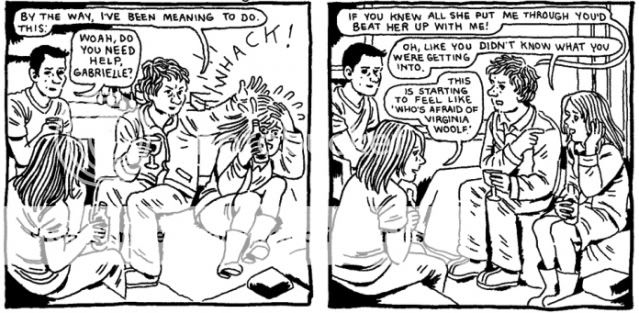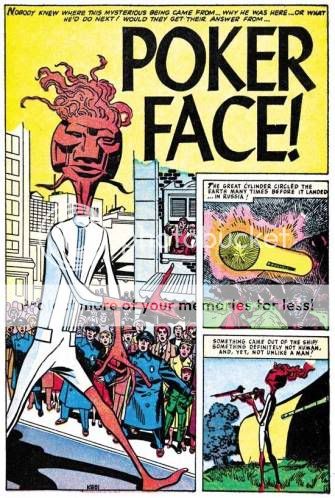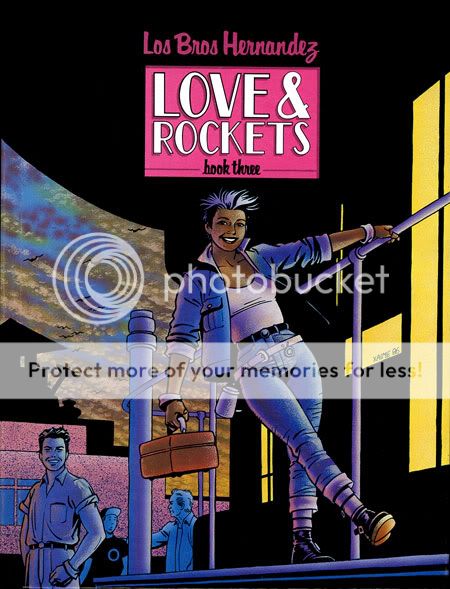Archive for September 9, 2010
’90s pop quiz: X-Men character or UK music act?
September 9, 2010Can you tell which is which? Note: In some cases this may be a trick question!
Aphex Twin
Archive
Arclight
Ash
Autechre
Bastion
Bishop
Blink
Blur
Boom Boom
Boyzone
Cable
Caliban
Cannonball
Chamber
Edwyn Collins
Graham Coxon
Graydon Creed
Curve
Cyber
Damask
Dark Beast
Domino
Donald Pierce
Dubstar
Elastica
Electronic
EMF
Empirion
Fatboy Slim
Fluke
Gambit
Gamesmaster
Gay Dad
Gene
Goldie
Cameron Hodge
Husk
Idlewild
KLF
Leftfield
Legion
Lush
Mansun
Massive Attack
Menswear
MLF
Nasty Boys
Oasis
Orbital
Pale Riders
Phalanx
Photek
Pipeline
Placebo
Prodigy
Pulp
Radiohead
Rictor
Ride
Senser
Shamen
Shatterstar
Skin
Sleeper
Space
Squarepusher
Strong Guy
Stryfe
Suede
Sugar Man
Tricky
Underworld
Verve
Westlife
Wild Child
(additional nerdery courtesy of Matthew Perpetua)
Carnival of souls
September 8, 2010* You bastards who are going to SPX this year will have dibs on the debut of ACME Novelty Library #20. Choke on it.
* I have not made a secret of my enthusiasm for Stephen Frears’s upcoming film of Posy Simmonds’s graphic novel Tamara Drewe, but wouldja believe that until I saw the new trailer below I hadn’t even noticed that the guy who played Evil Christopher Hitchens in Speed Racer was in it? Something must have been distracting me; I’ve no clue what it could be.
Yep, totally at a loss.
* The Missus and I have done a decent amount of biking near our suburban home recently, and the trip to the bike path usually involves coming or going along a very busy stretch of thoroughfare. This has made us hyper-aware of the difficulty, if not outright danger, posed to non-car travelers along such roads, whether bikers or pedestrians. That’s why this Matthew Yglesias post on ergonomic crosswalks and the need to psychologically recalibrate our conception of who owns the roadway brought a big smile to my face.
* The Economist profiles Jaron Lanier, author of You Are Not a Gadget. I still haven’t read the damn thing, but as I’ve said before, a cursory flipthrough delivered at least one mental paradigm shift for me, so it’s on the list. (Via Marc Hogan.)
* So too is Greg Milner’s Perfecting Sound Forever, if Milner’s interview with Matthew Perpetua is any indication. Fascinating stuff about the making of the sound of recorded music, from Steely Dan to Steve Albini, Mutt Lange to James Murphy.
* Sexy gothy vampirey stuff generally isn’t my thing–True Blood is sexy, gothy, and vampirey, but rarely all at once–but I stumbled across this piece called “The Turning” by Randis courtesy of my pal Lontra Phoenix and found it to be pretty hot stuff.
* The “deal with it” meme has reached its zenith. Shit, memes in general have reached their zenith. (Via Douglas E. Sherwood.)
* Rest in peace, Glenn Shadix. My wife and I have spent years, literally years, wondering aloud why Glenn Shadix in general and Otho from Beetlejuice in particular aren’t iconic. “I was one of New York’s leading experts in the paranormal…till the bottom dropped out in ’72.”
* Finally, take the time to soak in the despair of “Instructions for visiting the American Wilderness” by Thomas Blair over at the Awl. If you’ve ever had the suspicion that abandoned, for-sale, uncompleted exurban architecture and infrastructure are the telltale black buboes on the American body politic, this is basically “bring out your dead.” (Via Maura Johnston.)
Comics Time: Kaspar
September 8, 2010Kaspar
Diane Obamsawin, writer/artist
Drawn & Quarterly, January 2009
96 pages
$12.95
Again with the brown for the cover, but alright, fine, I’m clearly on the losing end of this aesthetic battle with D&Q and I accept that. What’s far more interesting here, and it’s a shame if the drab cover (not to mention the choice of grayscale for the interiors) obscure this, is the story of Kaspar itself. Or rather himself–Obomsawin here traces through contemporaneous accounts the life of one Kaspar Hauser, who for five years around 1830 intrigued and baffled European society with his amazing story of spending his first 16 years kept in total isolation with no human contact whatsoever before being taught some rudimentary language and handwriting by a mysterious man in black who then left him in Nuremberg to fend for himself. Kaspar’s story is one of a kind of cruelty my mind and soul virtually invert themselves to avoid having to deal with–I’m reminded of the story my wife told me from one of her psych courses, about a 19th-century experiment that used loud noises to condition a baby to be so afraid of bunnies that eventually he couldn’t even see a cotton ball without screaming. There’s something so unspeakably awful about human beings harming the human beinghood of a child right from the start that when I came across lines from Kaspar like “There is straw on the ground where I sit and sleep–it never occurs to me to want to stand up,” or the idea that he doesn’t know there even is anything else but himself, the bread and water he’s brought while sleeping, and the toy horse he’s locked up with, part of me just wants to run and hide. The trick of the book upon Hauser’s Chauncey Gardiner-like entrance into high society is using his literal inability to fathom the cruelty done to him (how can he–until now he had no context for what he was missing) and his appreciation for simple things like the color red or the concept of distance as a proxy for our own rejection of such monstrousness and a way to awaken our own lust for life respectively.
Of course, a visit to Wikipedia reveals that Hauser was almost certainly a peerless goldbricker, something his various patrons almost all cottoned to eventually, and from which the mysterious accidents and “assaults” that repeatedly befell and eventually killed him were likely self-inflicted to distract. Obomsawin’s choices to tell the story from Kaspar’s first-person perspective and to draw it in a simplistic, childlike, unadorned fashion we naturally scan as a direct outgrowth of Kaspar’s naivete–not to mention her one-page direct-address strip at the end, detailing her research for us, her “dear readers”–are a conscious effort to put aside the controversy and tease metaphorical meaning out of a story that’s too good to check. But if you’re like me, your mind already scrambled its way to “oh, this has gotta be a hoax, he must have been putting them on” long before you closed the book and opened up Google, and so the whole time you’re reading you’re wondering not just what Kaspar’s suffering, his reaction to society, and society’s reaction to him say to us–you’re wondering what the fact that someone could fake all that stuff says to us as well. I’m still wondering. In a way, the need in someone who’d do that is every bit as deep and devastating as the need in someone who was like that for real.
Carnival of souls: Special “Post-Labor Day weekend evening” edition
September 7, 2010* First things first: Don’t miss the morning edition of today’s Carnival!
* Also, for a few hours I had all the videos from my 80 Great Tracks from the 1990s list behind a jump, until I discovered that you can’t actually access the “after the jump” part of the post anymore. Sigh. Back into the main body they go; my apologies if this has the same deleterious effect on your browsing as it does on mine. I don’t like to metablog, but I want to assure my long-suffering readers and commenters that steps are being taken to drastically improve your Attentiondeficitdisorderly experience.
* Hey look, it’s a website and teaser trailer for Dash Shaw’s next animation project, The Ruined Cast. Shaw’s collaborators on this one include John Cameron Mitchell and Frank Santoro. For real. (Via Eric Reynolds.)
“The Ruined Cast” / Dash Shaw – demo teaser from Howard Gertler on Vimeo.
* Today on Robot 6: Download Jim Rugg’s Rambo 3.5 for free!
* Even though I have no brief with either of the two films it’s nominally about, I love this Matt Zoller Seitz piece on why we need more “adult” movies–movies that can’t be fully understood or enjoyed by children or the childish, as he puts it; “movies that let you spend time with morally compromised characters and that sort of hang back a bit directorially, letting the scenes and situations breathe, and mostly resisting the urge to tell you what the movie thinks of anyone, preferring instead to simply present the characters and let you feel however you want to feel.” I have to say, between this and his earlier, infamous “superheroes suck!” piece (Peter David notwithstanding), becoming a bit of an aesthetic scold is a good look for Seitz, much more so than it’s been for Roger Ebert, say. (Ebert’s been there for decades, of course.) I feel like there’s a connection to be made here between the mainstreaming of nerd culture and subsequent militant embrace of its most simplistic and bankrupt aspects and the way the recent acceptance of genre by comics’ smart set seems to have severely curtailed the discussion of non-genre work, but that’s probably poorly thought-through overreach and I know several smart people who tell me I’m just plain wrong about that anyway.
* Adam Lambert makes out with the Scissor Sisters’ Jake Shears while Katy Perry films it, and Judith Light makes a cameo. If that fails to sell you on watching this video, I give up. (Hat tip: Matthew Perpetua.)
Carnival of souls: Special “post-Labor Day weekend morning” edition
September 7, 2010* These long weekends have been bizarrely link-rich as of late, so rather than make this evening’s regularly scheduled Carnival more like a Disney Theme Park, I figured I’d throw an A.M. edition together. Great day in the morning!
* I did keep busy over the weekend–be sure to check out my list of 80 Great Tracks from the 1990s That Aren’t on Pitchfork’s Top 200 Tracks of the 1990s List.
* Well I’ll be a monkey’s uncle: Robin Hardy’s The Wicker Tree, the…thematic sequel, I guess? to his ’70s horror masterpiece The Wicker Man, is actually happening, and this teaser trailer is the proof. Nearly impossible to say for sure with a few lines of dialogue and five seconds of footage, but dare I say it actually seems good? (Via Bloody Disgusting.)
* whoa: “Right Thing the Wrong Way: The Story of Highwater Books”, an art show based on Tom Devlin’s late great publishing imprint and featuring work by Jeff Zekaj, Megan Kelso, Brian Ralph, Ron Rege Jr., Marc Bell, Greg Cook, Jordan Crane, and Kurt Wolfgang, coming soon to Boston’s Fourth Wall Project. I’m actually tempted to drive up there for this.
* Brian Chippendale’s If ‘n Oof is almost here!
* Recently on Robot 6: Ron Rege Jr.’s Yeast Hoist now available in convenient webcomic and beer formats;
* Chris Arrant talks to Paul Pope about THB and Battling Boy–one thing I like a lot about Paul is how candid he is regarding behind-the-scenes goings-on;
*and Chris Arrant also notes delays in Grant Morrison’s work for DC. It has to be a concern for the publisher that, for all intents and purposes, two guys drive their entire line. I’d be more worried about any hiccups in Geoff Johns’s schedule, given just how much of the line he holds down singlehandedly, how much the rest of the line revolves around the stories and events he cooks up, and the fact that he just got a major desk-job promotion that surely takes time away from his comics writing.
* Ooh, I really like the looks of this new stuff from the great John Hankiewicz
* Christ Almighty, Josh Simmons.
* Oh dear, I don’t much like the looks of this drawing called “meeting” by Renee French. Who or what is meeting who or what?
* Either it has disappeared from his blog or I bookmarked a bogus link, but regardless, a young Jason drew U2;
* Frank Santoro muses at length on inking and coloring in comics, and asks why the former is necessarily the basic stuff of drawing comics as opposed to the latter. He also posts some lovely looking work by Manuele Fior.
* Ben Morse of The Cool Kids Table takes a whack at my personal comics pinata: ’90s mutatnts with vague energy powers. I don’t think I realized just how vague they got–like, to the point of going for a year or two without even being introduced or explained–until I read Ben’s piece. “[Cable’s] powers would be incorporated into the character in a major way as time went on, but if you had said he was a super-fast typer or something, it wouldn’t have changed his first two dozen appearances.”
* I’ve been watching The Young & the Restless lately, and I’m so hugely thrilled by the density and byzantine complexity of the relationship drama on that show I can hardly tell you. To me it’s delivering in practice what serialized comic books are supposed to be delivering in theory. With that in mind I endorse Douglas Wolk’s call for more weekly comics, but without a lot of optimism. Of the bonafide weekly comics we’ve seen over the past several years, two have been among the worst comics I’ve ever read, and moreover I just don’t know if they’ll ever contain anything nearly as entertaining as Victor Newman.
* Over the weekend I saw several people on Tumblr lose they shit over this four-part essay on 28 Days Later and the allegorical difference between slow zombies and fast zombies by Christian Thorne. Longtime readers of this blog will be unsurprised to learn that I wasn’t quite as impressed, given how ruthlessly allegorical all readings of horror movies by non-aficionados have become and how inured (if not actively hostile) I am to them. Like most such readings, Thorne’s overreaches in some areas and elides complicating details in others. Meanwhile, the prestige of his trick here, in terms of the complexity of 28 Days Later, is sort of no-duh stuff if you ask me–certainly if you’ve ever seen any of the countless films well and truly referenced by the ending of that film, not to mention the similar audience-sympathy shenanigans of The Wicker Man. But I still think it’s worth your time, if only because, for me at least, the fast zombie is the enduring stuff of nightmares. Seriously, I had one this weekend! The more information I can get on why they bother me so much, the better, even if I’m reasonably sure it has nothing to do with a craving for the Strong Leader. (Given my history you don’t need to look as far afield as my affection for Zack Snyder’s Dawn of the Dead remake for evidence of that!) (Via Mike Barthel, among others.)
* Andy Khouri has been creating cool little grids of album art for various astutely art-directed artists’ complete works. Here’s New Order, and here’s Bjork, and I’m told there are more to come. I saw this done with the Smiths and Morrissey once; talk about a guy with a well-formed aesthetic.
* Finally, Rob McMonigal reviews seven Matt Wiegle minicomics, including my own collaboration with Matt (and Matt Rota and Josiah Leighton), Murder. He says nice things, which will help me get through the day.
Music Time: 80 Great Tracks from the 1990s That Aren’t on Pitchfork’s Top 200 Tracks of the 1990s List
September 7, 2010I enjoyed Pitchfork’s list of the Top 200 Tracks of the 1990s. The decision to limit the list to one song per artist opened things up to tons of songs, probably even whole genres, that would have been excluded if folks like Bjork and Beck and Radiohead each had five songs a piece or what have you; moreover it started a whole different set of discussions than “‘Let Down’ should have been ranked higher than ‘Creep,'” which is probably what you’d have gotten otherwise. Still, as with any exercise of this sort, there are bound to be lacunae, oversights, goofs, choices you’d have made differently, artists you’d have better represented, and of course outright crimes against all that is holy. LOL srsly the closest thing I have to a substantive philosophical criticism of the list is that in the end, the voters admittedly went with comfort for their #1; given that the list has frequently been positioned as a statement about indie music today, read into that what you will. In my case, seeing the #1 vote-getter (no spoilers here!) simply reminded me that my 1990s were different from those of a lot of other critics–less “indie rock,” more “alternative,” electronic, heavy, and industrial.
So in the interest of showing my ’90s off a bit, here, in alphabetical order by artist, are 80 wonderful songs from that wonderful decade for music that didn’t make Pitchfork’s cut. I applied three rules in making this list:
1) Like Pitchfork, I limited myself to one song per artist.
2) If an artist made Pitchfork’s Top 200 list, I couldn’t use them–in other words, I wasn’t adjudicating whether “Donkey Rhubarb” would have been a better pick than “Windowlicker.” (Although it is.)
3) Pitchfork very helpfully and very smartly included two or three “see also” suggestions with every entry, in order to give relevant sounds/scenes/artists that much more props. I didn’t let this rule out artists who were thus listed, but I did let it rule out the individual songs that were cited. As a practical matter this meant that several songs which all things being equal I’d have included on any Top Whatever List didn’t end up making it in, because the song Pitchfork had suggested as a “see also” was so clearly the right choice–“Stars” by Hum, “Gett Off” by Prince, “Woo-Hah!! Got You All in Check” by Busta Rhymes, “Jump Around” by House of Pain, and “Unsung” by Helmet all come to mind. But more often than not I had the leeway I wanted.
So there you have it. There was a lot of great music made in the days of my youth; here’s some of it, in convenient video form. I hope you enjoy!
Comics Time: Fallen Angel
September 6, 2010Fallen Angel
Nicolas Robel, writer/artist
Drawn & Quarterly, July 2006
80 pages
$9.95
Stop me if you think that you’ve heard this one before, but I don’t get dreary brown book covers like this one–especially this one, given that the art inside is done in comparatively cheery hues of red and green as well as brown. This time around, however, the content is just as baffling to me as the package. Robel tells a fairy-tale-like story about a little man named Barnabe who lives in a Central Park-type oasis in the big city but is haunted by nightmares in which he becomes a giant and can’t help but leave a trail of destruction wherever he goes. One day an actual giant appears and magically conjures up three giant beautiful women, with whom Barnabe falls in love. When two of them spurn his advances, he either tries and fails to commit suicide Groundhog Day-style or just contemplates it, I’m not exactly sure. But then the third woman feels fond of him after all and starts looking for him, but by then it’s too late–he’s built Icarus-style wings for himself and taken a header off a cliff. Once he lands he snuggles with the woman, and there’s some narration about how he hadn’t noticed that his isolated life had changed, and then he lives in the city all of a sudden. Robel is using the dream logic of fairy-tale storytelling, obviously, but the symbols and rhythms and analogues make little sense either on their own terms or in terms of extrapolating them to a real-world moral, especially given the frequent disconnect between the narration and the events of the story. (I suppose it could be thinly veiled autobio, but in that case it never transcends the personal.) Robel has a memorably jagged take on the cute, round-headed little characters that populate many alternative comics of this sort, one that’s clearly of a piece with his hand-lettering, but it’s not so attractive or unusual that it overcomes the book’s other shortcomings by, say, creating cohesive and inviting environments, or even simply being really pretty to look at. Shrug.
Carnival of souls
September 3, 2010* Two great items of Ron Rege Jr. news, courtesy of Jordan Crane: Yeast Hoist #15, which is part-minicomic, part-BEER, is now available for purchase; and all fourteen issues of the series up until that point will be going up on Crane’s What Things Do site eventually.
* Bon chance to altcomix lifer Rebecca Rosen as she departs Drawn & Quarterly for the amazingly even tonier comic-book confines of Le Dernier Cri and Delcourt. Always a welcome, welcoming face at shows!
* Geoff Grogan made a video for his excellent comic Fandancer.
* That’s Professor Jeffrey Brown to you, pal.
* Jeez, the Sharkticons. I barely remember Transformers: The Movie at all–my memory of unsuccessfully trying to go see it after some Sunday-afternoon soccer game is clearer than my memory of the movie itself, whenever the heck it was I actually did see it–but what stands out is the incandescent creepiness of the Sharkticons and those three-headed floaty guys and killing off the lead characters and all that stuff. Children’s entertainment did strange things to its audience back then.
* Mondo Tees is having a 30% off sale this weekend. They’re the people who have that series of shirts that combine metal-band logos with director names–Herzog/Danzig, Ingmar Bergman/Iron Maiden, De Palma/Def Leppard, etc. If you’ve ever wanted one, now’s the time!
Comics Time: Nicolas
September 3, 2010Nicolas
Pascal Girard, writer/artist
Drawn & Quarterly, December 2008
64 pages
$9.95
Let’s get two visual elements out of the way: 1) This is one of D&Q’s many, many little brown books, and I don’t understand the attraction to that ugly color; it makes books look like galleys to me. 2) Pascal Girard’s loose, messy minimalism is so close to Jeffrey Brown’s in appearance and effect, particularly in terms of character design, that this is practically a J.B. tribute album; not at all surprising to see Brown show up in the thank-yous. That said? Oof, this is a little gut-punch of a book. It’s a very minimal memoir dealing with the death of writer/artist Pascal Girard’s little brother Nicolas when both brothers were little boys, and how that loss has affected Girard’s life ever since. Starting it off with a three page section called “BEFORE” featuring the two boys playing Ghostbusters together, then abruptly transitioning to “AFTER” with a shot of Pascal sitting there alone is just one example of how pointed and to-the-point this book gets. I’m particularly struck by the decision (a very un-Brownian decision at that) to eschew panel borders and backgrounds entirely and rarely if ever telegraph temporal or spatial transitions. Each page contains two images, almost more doodled than drawn, floating atop the white paper, like the sudden flash of isolated, painful childhood memories to the surface of your otherwise formless and featureless sea of memory. Some sequences are almost too difficult to bear–Pascal clutching his pillow with increasing intensity, his eyes welling with black tears like stormclouds, as his parents finally tell him the story of Nicolas’s final hours; the final flashback, ending with an almost manic number of HA HA HA HA HAs as the two brothers, oblivious as to what is to come, laugh together. Somehow that laughter is an indication of a pain that will never go away.
Carnival of souls
September 2, 2010* Today on Robot 6: read Mark Waid’s keynote address on copyright and piracy;
* and Scott Pilgrim in space!
* Zak Smith brainstorms for his post-apocalyptic mutant-ninja-animal-hybrid RPG. Possible setting: “Labyrinth of The Black Wyrm, District of Columbia.”
* A student/teacher’s guide to the Bordwell/Thompson blog 2009-2010.
* Animal Kingdom, you say? Hm, alright.
* Peerless contemporary choral composer/heartthrob Eric Whitacre talks about assembling his own private choir and recording his upcoming collection Light and Gold. One thing I love about Whitacre besides the fact that he’s handsome for a man is that he talks about his music the same way I talk about his music–like its beauty is almost something to be endured.
* I wonder how many people will fall in the pop-cultural Venn diagram overlap of caring that guitarist Wilko Johnson from UK pub-rock progenitors Dr. Feelgood has been cast as the executioner in Game of Thrones.
Music Time: Jane’s Addiction – “Up the Beach”
September 2, 2010Jane’s Addiction
“Up the Beach”
from Nothing’s Shocking
Warner Bros/WEA, August 1988
This right here is almost everything Jane’s Addiction did well: a gooey Eric Avery bassline, a huge Zeppelin Over Sunset power-chord onslaught, Stephen Perkins’s super-produced pounding, and Perry Farrell’s otherworldly wailing, equal parts vulnerable and Valhalla, introduced by that perfectly intimate intake of breath. Atop this, Dave Navarro (who was the best starfighter pilot in the galaxy before he turned to evil) constructs these gargantuan spires of guitar, effortless edifices that majestically tower into the atmosphere and cascade back down into the surf. The funny thing is that the lyrics simply say “Here we go now–home,” but there’s nothing homey about this music at all–it’s music of epic adventure and grandiose, self-consciously exotic beauty. The only conclusion that we’re left to draw is that this is home for Jane’s Addiction, a whole new concept of home constructed by Perry and company through sheer willingness to be weird outsiders and artists and hedonists. This song isn’t a day at the beach at all, it’s them welcoming you to their place and saying “Here, let me give you the grand tour.”
Carnival of souls
September 1, 2010* Chris Arrant has a pretty great interview with cartoonist Hope Larson up at Robot 6. It’s split pretty evenly between her adaptation of A Wrinkle in Time by Madeleine L’Engle, her upcoming magical-girl collaboration with Tintin Pantoja Whois AC, and general process questions. That’s where the meatiest stuff lies:
Arrant: Becky Cloonan has stated that after doing an OGN, she liked doing serialized stories more because she gets more feedback and can talk about things longer. Have you thought about doing any serialized work?
Larson: I haven’t seriously considered it, no. I’m not too interested in anyone’s feedback except for my editor’s; I’m not doing comics by committee. When I was involved with the Flight anthology that was very much the atmosphere, and it didn’t much appeal to me. I tend to think that the more sources you solicit feedback from, the blander your end product will be.
I also don’t think there’s an acceptable vehicle to serialize the kind of work I do. The Internet’s great if you’re willing to hustle, but I’m not. And floppies…Well, what publisher would be willing to publish a YA girl story in a monthly or bi-monthly format? On top of that, the editorial relationship I want isn’t possible if I’m not working on large chunks of story at a time. For me, short-form serialization — anything under 100 pages or so — seems like a lose-lose situation.
That’s a refreshing lack of fell-goody prevaricating right there.
* Ron Rege Jr. says the first eight issues of his series Yeast Hoist are all going up on What Things Do. That’s wonderful news–I’ve never seen this stuff before.
* Via everyone: You can download all four issues of Daniel Raeburn’s seminal monograph series The Imp for free. One issue each on Daniel Clowes, Jack Chick, Chris Ware, and Mexican pulp comics. I’m looking forward to kicking around with these when I have a little more time.
* Tough to top this photo from an interview with retailer/blogger Chris Butcher of the Beguiling in the National Post. (Via Peggy Burns.)
* I think maybe my single greatest achievement as a comics collector is owning every issue of Acme Novelty Library, especially since I came late to the game (1999 or so) and the early issues are so hard to find and I had no idea just how worth owning they all were when I started getting them. Point is that even if you own Jimmy Corrigan, you wanna get one of the 20 copies of the out-of-print Acme Novelty Library #12 that Fantagraphics just found, if you can.
* Matthew Perpetua explains the methodology behind Pitchfork’s Top 200 Tracks of the 1990s list. Very interesting, especially the fact that the decision to limit every artist to one song apiece came after the voting. I imagine I’d have voted a lot differently if that parameter were in place from the jump, or at least from after the compilation of the shortlist from which participants could select their songs.
* Even though I haven’t seen the movie, this is just a lovely look at Rainer Werner Fassbinder’s Chinese Roulette by Jason Adams.
* Ta-Nehisi Coates on bread pudding, Wolverine, and the perils of TMI.
* Johnny Ryan does a Pushead pastiche for a new t-shirt. Metaliban is pretty great.
* Real Life Horror: I assure you that you want to read the demands of the gunman who stormed the Discovery Channel’s offices today:
Saving the environment and the remaning species diversity of the planet is now your mindset. Nothing is more important than saving them. The Lions, Tigers, Giraffes, Elephants, Froggies, Turtles, Apes, Raccoons, Beetles, Ants, Sharks, Bears, and, of course, the Squirrels.
The humans? The planet does not need humans.
* Truly they were the Masters of the Universe. Man, there’s nothing I love more than “third way” villains fighting the main villains.
* Finally, fuck it, I’m posting this John Romita Sr. drawing again. My Lord.
Comics Time: Snake Oil #5: Wolf
September 1, 2010Snake Oil #5: Wolf
Chuck Forsman, writer/artist
self-published, 2009
20 pages
$4
I think there’s something on the verge of being really, really good here. Forsman’s wispy, hesitant line and Segar and Gray by way of Chester Brown and Sammy Harkham character designs can at times feel a bit unmoored against his backgroundless panels–I never quite buy their physicality. But it’s a lovely style, one that makes his characters instantly sympathetic, particularly the hefty, good-natured title character with his wilted mohawk and Sears uniform, but also even the abrasive, adenoidal types with whom he interacts. And that in turn is key to making the umpteenth “’80s ennui among the Great American Nowhere’s lower middle class” comic you’ve read feel, if not fresh, then at least deeply felt rather than a report from a rear-view mirror. Several of the moments Forsman selects to highlight in this day in the life are really astutely observed and wincingly sad, recognizable to anyone who’s overstayed their welcome in suburbia with shit jobs, fast food, small-hours onanism, and well-meaning reprimands from the family with whom he’s saddled himself. (Take that either way you want.) The ending in particular killed me, and I could return to the page where Wolf eats a burger and fries by himself over and over. Forsman clearly has enough control over line, pacing, and story that this is the sort of comic you read as much for the promise of future ones as for this one itself. I look forward to that future.
Carnival of souls
August 31, 2010* Brian Chippendale is doing a webcomic called Puke Force for PictureBox! Lotsa laffs and sex so far.
* Tom Neely presents Bound & Gagged, 72 pages of one-panel gag comics by Andrice Arp, Marc Bell, Elijah J. Brubaker, Shawn Cheng, Chris C. Cilla, Michael DeForge, Kim Deitch, J. T. Dockery, Theo Ellsworth, Austin English, Eamon Espey, Robert Goodin, Julia Gfrörer, Levon Jihanian, Juliacks, Kaz, David King, Tom Neely, Anders Nilsen, Scot Nobles, Jason Overby, John Porcellino, Jesse Reklaw, Tim Root, Zak Sally, Gabby Schulz, Josh Simmons, Ryan Standfest, Kaz Strzepek, Matthew Thurber, Noah Van Sciver, Dylan Williams, Chris Wright and more. Jeepers creepers!
* Now that I’ve started to “get” Gabrielle Bell, I’m enjoying her ongoing account of her trip to the San Diego Comic-Con. Guest-starring Michel Gondry, pictured here slapping Bell in the head. (Via Tucker Stone.)
* Today on Robot 6: Scott Kurtz on the Mark Waid/Sergio Aragones piracy/copyright kerfuffle;
* and C.B. Cebulski doesn’t want to read emails from people named DarkLoganXX.
* Myyyyyy goodness, John Romita Sr.. My goodness gracious me. (Via Tom Spurgeon.)
Music Time: Usher feat. Nicki Minaj – “Lil Freak”
August 31, 2010Usher feat. Nicki Minaj
“Lil Freak”
from Raymond vs. Raymond
LaFace, March 2010
It takes some truly breathtaking chutzpah to recast Stevie Wonder’s epic, epochal social-awareness scorcher “Living for the City” as the “Kashmir”-style hook for a song in which the singer hectors a groupie into fucking another woman for his viewing pleasure. Even a guy like me, who’s self-published his opinions on everything on a near-daily basis for the better part of a decade, can only glimpse that kind of ego from where I’m standing with the help of a Hubble-level telescope. Fortunately, Usher Raymond is just the creep for the job. The dour, diminutive man who would be King of Pop has no compunction tarting up that “la la la la” hook with exotica strings and deploying it as the backing track for a paean to fauxbianism that repeatedly features the phrase “You let her put her hands in your pants.” The second it dawned on me that yes, that’s what he’s doing, I laughed out loud at its gloriously bad taste and thought “Oh, I’m downloading this, alright.” Sacrelicious!
“Lil Freak” really has three selling points to overcome Usher’s sunglasses-at-night anti-charisma. One, that huge, absurd hook in the chorus. Two, the subtle, atmospheric pulsing tone that by the second verse is pretty much the only instrumentation besides percussion–it’s got this weird subterranean-lair vibe to it that suits Usher’s sexual supervillain persona in the song. Third, guest rapper Nicki Minaj, the aptly named (I don’t think I’d gotten the pun of her last name before just now) Harley Quinn to Usher’s unsmiling Frank Miller Joker. I don’t think Usher has any idea how ridiculous what he’s up to with this song is, but Minaj certainly does–how else to explain a verse in which she lists all eight of Santa’s reindeer, uses the phrase “tig ol’ bitties,” and barks “EVERYBODY LOVES RAYMOND!” in praise of her host singer with all the comical ferocity of that guy who refers to the Lord Humungus as “the Ayatollah of Rock ‘n’ Rollah” in The Road Warrior? Let this song put its hands in your pants.
(via Matthew Perpetua)
Carnival of souls
August 30, 2010* We will never exhaust Jack Kirby’s contribution to art and ideas.
* This oughta be fun: Pitchfork counts down the Top 200 Tracks of the 1990s. Only one song per artist, which makes it something different than a real Top 200 Tracks countdown, but different doesn’t necessarily mean “worse.”
* Ron Rege Jr.’s Yeast Hoist #1: Now appearing in its entirety at What Things Do. What a treasure that site’s turning out to be.
* There used to be a review of the script for Guillermo del Toro’s At the Mountains of Madness adaptation right here, but now there’s not. Not sure what that means, and god knows you can’t trust these sorts of things anyway, but it sure sounded like the creature-feature action flick you were worried it was gonna be, and I don’t trust del Toro not to screw it up just that badly. (Via Jason Adams.)
* DC’s Source blog reveals the division of labor for the Batmen starting this fall: Dick Grayson will star in Tony Daniel’s Batman, Scott Snyder’s Detective Comics, and Peter J. Tomasi’s Batman and Robin, while Bruce Wayne will star in Grant Morrison’s Batman Inc. and David Finch’s Batman: The Dark Knight.
* I’m quite pleased that the time differential between the release of a new Jason comic in Europe and the States is now on the order of two months.
* My friend Zach Oat loved Neil Marshall’s Centurion, which now that I’ve seen Scott Pilgrim and The Expendables is solidly on top of my to-do list. (Sorry, Inception.)
* Nice, chewy posts on a couple of comic-art traditions from a couple of talented comics artists: Frank Santoro on naturalism and Tom Kaczynski on melodrama.
* Today on Robot 6: Cartoonists and the Criterion Collection: perfect together! Featuring Matt Kindt, Scott Morse, Jason Latour, R. Crumb, Adrian Tomine, Jaime Hernandez, Bill Plympton, Frank Kozik, Seth, Scott Campbell, and more.
* Jiminy Christmas, look at the Eric Vincent colors on this old Love and Rockets collection. This is what I want the ’80s to look like.
* A giant-monster movie made on the cheap called Monsters? Sure, I’ll eat it.
* Robyn covering Bjork’s “Hyperballad.” Oh my goodness. (Via The Missus.)
* I’m quite late to this party I know, but you certainly want to watch director John Hillcoat’s video for the Nick Cave outfit Grinderman’s “Heathen Child.” It’s the sort of video where when the chorus kicks in, the tits come out. It’s like, wait, the people who made this crazy thing, which looks like the work of people who’ve watched nothing but True Blood and Tim and Eric for the past three years, made that tedious, polite adaptation of The Road and recorded its generic-Oscar-bait score? Can we swap out that version of them for this version of them and try again?
Comics Time: Set to Sea
August 30, 2010Set to Sea
Drew Weing, writer/artist
Fantagraphics, August 2010
144 pages, hardcover
$16.99
Read it for free at DrewWeing.com
It’s an odd little notion, the idea that you’ve lived a better, fuller life for having killed people. That’s probably a somewhat unfair aspect of Drew Weing’s good-natured, lushly drawn storybook (that’s the term the comic practically demands I use) Set to Sea–a tale of a big lummox of a poet whose lackluster verses about life on the open sea are given new verve when he’s shanghai’d into service on an actual ship–for me to seize on. After all, Weing’s bigfooted style and inviting rather than intimidating illustrative chops place him squarely in the adventure-comics tradition of Carl Barks and Jeff Smith. Why be churlish and begrudge its central character’s baptism by fire? Well, because it really is the central, transformative moment in his story. Before the pirate raid that he ends up beating back pretty much singlehandedly by slaughtering dozens of buccaneers and beating their captain to death in a rage, he’s miserable aboard his new home–complaining about the work and the rations, literally tossing his notebook full of unfinished poems into the ocean. Afterwards, he’s accepted by his shipmates, elected third mate, introduced to a world of beauty and adventure around the globe, and filled with enough genuine insight into the sailor’s life to become a hugely popular poet back on the mainland. At first I was impressed by how wordlessly nasty that central fight got, how Weing was unwilling to neuter the violence of this world. But by the time we get to the end of the book, with the now-respected poet/sailor, bearded and eyepatched, reclining by the fire of the pub from which he was once forcibly ejected, thinking back on a life well lived…well, this isn’t like Bilbo Baggins, forever trying to recapture his combat high, or Frodo Baggins, forever damaged by the horrors he witnessed and endured. It’s a dude kicking back saying “Yeah, it was all worth it.” I wish Weing had examined that assumption a little more closely.
I’m getting too old for this shit
August 30, 2010Sylvester Stallone’s Rambo was my favorite film of 2008. Disturbing in its combination of Saving Private Ryan-style war-atrocity gore with might-makes-right anti-heroism, practically confrontational in its abandonment of traditional peaks-and-valleys action-movie plot structuring, it felt like the searingly personal product of someone who was mentally ill. By contrast, The Expendables feels like the product of someone who’s sustained an impairing head injury. Should’ve expected it, I guess; no one assembles enough aging action heroes to stage their own private Royal Rumble with the intention of exposing their own heart of darkness, or really doing anything but remaking Tango & Cash with more ampersands. But I was still surprised by just how spastic and disconnected everything felt–characters, scenes, dialogue, basic narrative cause and effect, everything. It was like watching an action movie written by Samuel Beckett.
Not that you even need to know this, but the plot is that Sly and his fellow mercs, to whom we are introduced during an in medias res rescue of hostages from Somali pirates (conducted with rather callous disregard for the hostages, I must say!), are hired by a mysterious company man (that’s Bruce Willis’s cameo; Stallone’s group takes the gig when Arnold Schwarzenegger passes on it) to depose the military junta ruling a tiny island nation in the Gulf of Mexico. Stallone and Jason Statham (there really is no point in using their character names–Stallone and Statham are their character names) scout the place with the help of the rebellious daughter of the ruling general, who refuses to leave with them after they’re discovered. Touched by her loyalty to her people and her home, , Stallone overcomes his reluctance to take a surefire loser gig like this, and he and his team travel to the island, murder its entire armed forces, kill Eric Roberts and Stone Cold Steve Austin (the rogue spooks secretly running the show), leave the daughter in charge, and go have beers with Mickey Rourke. Cue both “Born on the Bayou” AND “The Boys Are Back in Town,” The End.
Alright, so with a little effort I can make it sound coherent, but you’ve got to cut a buncha subplots to do it. Dolph Lundgren is featured as a member of the team who goes Section 8 during the pirate attack and is kicked off the squad; having read the location of Sly’s next gig over his shoulder, he presents himself to the island junta and leads a team of assassins in a fleet of SUVs to take out Stallone and Jet Li (here playing a character called, no I’m serious, Yin Yang). Just before he can kill Li, Stallone shoots him, and in his dying breath he gives Sly the entire layout of the presidential palace they’ll need to raid. Only he’s not really dying, he actually gets better, and in the final scene all is forgiven and he’s having drinks and riding motorcycles with the gang again. Phew! Meanwhile, Charisma Carpenter is briefly poured into a minidress and paraded around as a Lifetime Movie-worthy domestic-abuse subplot so that Statham can pound the shit out of her asshole new boyfriend and his pick-up basketball playmates during his off-hours as a way to show her what she gave up by dumping him. Li wants more money for his family, which he doesn’t actually have, and he’s angry because as the shortest member of the team he gets shit-on a lot, and all his fights are so choppily edited you’re left to wonder if they were removing his walker in post. Mickey Rourke, team member turned team manager, runs a tattoo parlor or an auto body shop or both, enjoys sex with anonymous women, and cries because this one time in Bosnia he could have stopped a woman from killing herself but didn’t. Next time you see him after that he’s whooping it up with the team with John Fogerty chooglin’ in the background. The general who rules the island nation is chafing at having to take orders from Roberts and Stone Cold and this other British merc with a Fu Manchu mustache, and he’s a painter, so he has all his goons paint their faces like scary warriors, so Roberts shoots him to death in front of all his men; none of this changes anyone’s behavior in the slightest.
Again, not a huge surprise that an action movie consciously constructed as a throwback to the ’80s heyday of its writer/director/star and several of its supporting cast members and cameos was going to feature a lot of cliched go-nowhere barely-sketched-out subplots featuring characters for whom the jump from one- to two-dimensional constitutes an arc. The really shocking thing for me was how incoherent the basic stuff of storytelling was here. Remember in Tango & Cash how nearly every line of dialogue was a one-liner, and after a while it felt almost absurdist, like there was no real connective tissue between any of them and Sly and Kurt Russell were just taking turns spouting zingers from some sort of checklist they had? This was like that, only the zingers had no zing. I’m finding this so difficult to describe…it’s like, you’d see a reaction shot from Stallone when one of his teammates said or did something, he’d be smiling and he’d make some wisecrack, but nothing that the teammate said or did actually merited the specific thing he said. They could have said or done something totally different, or nothing at all, and it would have had the same bearing on what the next line was. This black-box-theater experimental-theater tone carried over into the lines of dialogue that actually purported to have some sort of import for the story: After Sly pops Dolph during his heel turn, he asks him “Who sent you?”, and then before Dolph even answers he asks “Is the girl still alive?” as if he already knew the answer. During the climactic raid on the presidential palace, Stallone announces that the team has three minutes to infiltrate the place and do…something, I forget what, but it doesn’t matter, because we never learn or are shown why there’s this three-minute time frame–nothing happens three minutes later, there’s no timers involved in the explosives they’re planting, there’s not some big event the general is launching in three minutes, the plane’s not taking off in three minutes, nothing. Like, you can poke fun at the motivational shortcomings these movies always have–for instance, Stallone being so moved by the daughter’s courage and loyalty to her nation and people, something he’d apparently never encountered before despite alluded-to adventures everywhere from Bosnia to Nigeria–but it’s the fundamental disconnect between any two points in the film that’s the real marvel here. It’s Mystery Science Theater 3000-level material at times, even aside from Stallone and Rourke’s Rondo Hattonesque visages.
But the action is fabulous, I’ll give it that. Not necessarily the hand-to-hand combat scenes: There are some memorably brutal bits toward the end with one of the key goons getting his neck snapped back with a downward kick, and Statham is a joy to behold in close-quarters brawls as always, but for the most part these are old men, and Stallone Christopher Nolans the bejesus out of their fight scenes just to make them look like fight scenes. The firefights, on the other hand? Wow. Stallone announces his intentions here from the start, when a “warning shot” at the pirates from Lundgren literally blows a man in half, sending his entire torso splattering against the wall behind him. Stallone’s a poet with CGI splatter, and the big battles make the most of this by combining it with novel weaponry–Terry Crews’s automatic shotgun gets some real animated-GIF-worthy killing done, while Stallone and Statham’s “well, while we’re here, we might as well…” biplane strafing run against a dock full of army dudes had me laughing and cheering. There’s even one memorable bit seen through heat-vision goggles, great gouts of yellow blood spraying everywhere like the Sesame Street Chain Saw Massacre. I’ve often said that the great ’80s action movies treat the action like a Busby Berkeley dance number–it’s spectacle, and the spectacle is pretty spectacular here once it gets going. Problem is that when no one’s getting killed, the movie’s nearly unwatchable.
Carnival of souls
August 27, 2010* One quick programming note: My review of Scott Pilgrim vs. the World went out over RSS earlier today with a paragraph missing–a whole shpiel about Ramona vs. the Manic Pixie Dream Girl and Scott as Knives’s Manic Pixie Dream Boy–so if you’re interested, please click again to make sure you got the whole thing.
* Recently on Robot 6: A first look at Hope Larson’s A Wrinkle in Time.
* Wait–a new THB issue from Paul Pope and AdHouse? Whaaaat? (Via Tom Spurgeon.)
* Returning to it a couple days later–like flying over a still-gushing oil spill–I find it hard to overstate what a trollish, narcissistic, pointless disgrace the Comics Journal’s roundtable on Ben Schwartz’s Best American Comics Criticism became.
* Speaking of! The programming slate for SPX has been announced. I can’t go this year, and even though this is because of entirely pleasant personal reasons, I’m still bummed out because I’d give my eye teeth to be able to participate in the Critics’ Panel again this year, or even just attend it: Johanna Draper Carlson, Gary Groth, Tim Hodler, Bill Kartalopoulos, Chris Mautner, Joe McCulloch, Ken Parille, and Caroline Small. Sparks really could fly at this thing, and ought to. At the very least, allow me to beg someone to record it! (Via Tom Spurgeon.)
* Here’s a fine David Bordwell essay (is there any other kind?) on coincidence in film narrative. Read the whole thing, just for the pleasure of having done so.
* A lot of people got really excited to see Kevin Huizenga’s story “Time Travelling” go up on Jordan Crane’s webcomics site What Things Do, and I don’t blame them, but mostly it makes me think of how many people I’d kneecap to get Huizenga’s “A Sunset” online. It’s from Or Else #2 and I’m reasonably sure it’s the best short comic story of century so far.
* Jason draws Darth Maul, Batman, and a Teletubby WHOOPS a Moebius character (LOL! thanks Jog), Jason-style.
* Wow, “Always Loved a Film,” the most straightforwardly fun Underworld song ever, now has the most straightforwardly fun Underworld video ever!
* There’s no way to say this without coming across like a complete tool, but since it’s not like it’d be the first time, here goes. Tomorrow is apparently Read Comics in Public Day. I know that everyone’s heart is in the right place, but every day is read comics in public day for me because I’m a grown-up who owns his life choices. It’s no big deal.
Continue Y/Y?
August 27, 2010Scott Pilgrim vs. the World felt natural. Which is an odd thing to say about a romantic comedy punctuated by video-game-style fight scenes the way Grease is punctuated by John Travolta singing, I suppose, but then that’s just how in tune I am with what’s going on with this movie. Watching it simply reinforced that huge eureka moment I had when I first read Bryan Lee O’Malley’s comic and discovered how he’d incorporated the visual and structural language of videogames into a twentysomething slice-of-lifer. Fights, leveling up, people turning into coins when they get defeated, warp zones, 1-ups, ninja swords, sound effects, stats–this stuff has been part of the fabric of my mental life for so long that it’s difficult to describe how simultaneously familiar and thrilling it feels to see it in an everyday kinda context, right there among rock dudes and cute girls and tagalongs and witty slutty gay guys and awkward parties and scenesters and so on and so forth. Of course it should be there!
And it was naturally funny, too. I think one thing that gets lost in discussion of co-writer/director Edgar Wright’s genre send-ups is how much of the humor has little to do with riffing on Night of the Living Dead or Bad Boys or whatever the case may be and stems instead from the effortless interaction of characters who’ve gotten to know each other, play off each other’s insecurities, and draw out each other’s funniest stuff. In that sense Scott has a lot more to do with Shaun of the Dead than with Hot Fuzz in that it’s about a group of young, slightly directionless young people who’ve mostly been friends forever–there’s that same sense of people putting on their roles in the group like a pair of comfortable shoes and kicking around their affection for and annoyance with one another like a soccer ball. So for all the screwball pacing and dialogue it had a…laconic feel to it, I think I wanna say? Like, it was super-easy to slide into the group and laugh at Wallace’s knowingness and Scott’s blithe sleaziness and Julie’s GTFOness and Knives’s head-over-heels-ness and Young Neil’s wannabe-ness and Kim’s grumpiness and Stephen’s panicked ambitiousness Stacey’s annoyingly right-ness and so on and so forth, like we’d known these folks all our lives.
Heck, even the most potentially problematic character in this regard, literal dream girl Ramona, was played pretty much straight–Mary Elizabeth Winstead’s comparatively flat performance vs., well, everyone else in the movie could be seen as a mistake, but to me it was the perfect way to thwart any potential Manic Pixie Dream Girlisms. Indeed, that character comes across like a point-by-point refutation of the MPDG–dry rather than manic, she makes Scott’s life a disaster rather than an adventure, and the only whimsical thing about her, her hair, is treated like a sign of emotional problems and an intimidating obstacle to be overcome. Most importantly, the whole point of the movie is that her life existed in and of itself long before she entered Scott’s. She’s got a long, troubled history and a rich emotional life–she’s an agent, not an object. If anything, it’s Scott who’s Knives Chau’s Manic Pixie Dream Boy, transforming her life into a swoony spectacular with his carefree indie-rock lifestyle and heretofore unchallenged ability to ignore and deny anything troubling in his own past and emotional life. And of course we see just how far that gets everyone involved!
Narratively bold and inventively staged in all the ways that O’Malley’s comics are, and very very very funny, Scott Pilgrim was basically a killer little movie that could easily have felt forced and over-impressed with itself. If anything, it was a little slow at times, which is the last thing I thought I’d be saying. There was no sense that the movie was desperate to bring its material to you, you know? There it was, and you could come to it at your leisure. I wanna play it again!






